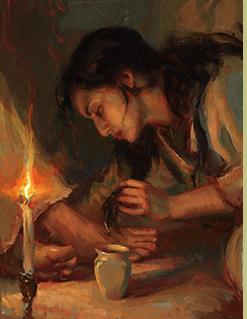Foot Washing in a Pandemic
As it has been for many, being in the coronavirus lockdown has meant that time has started to go a little wonky for me. I didn’t realize until this Saturday (four days into April) that it was April. This cognizance brought me to the reeling conclusion that the upcoming week was going to be Holy Week and that, for the first time in my life, I was not going to be able to attend the services, which are my favorite of the liturgical year. As an introvert I have not really mourned for the inevitable wash of cancelled plans, but I did mourn this. And on Holy Thursday, a day where we would normally wash one another’s feet, the isolation and loss of physical contact feels particularly poignant. So, the question I would like to pose at such a time is this: How do we wash one another’s feet at a time when touch is potentially deadly?

In answering this question, I’d like to look not only at Jesus washing the feet of his disciples, but also at the act which prefigures this scene: the woman who washes Jesus’ feet. After washing his disciple’s feet in today’s gospel from John, Jesus explains his actions, saying: “Do you realize what I have done for you? You call me ‘teacher’ and ‘master,’ and rightly so, for indeed I am. If I, therefore, the master and teacher have washed your feet, you ought to wash one another’s feet. I have given you a model to follow, so that as I have done for you, you should also do.”
This gives us a window into how Jesus views the actions of the woman who washed his feet. As he is now teaching his disciples how to serve one another, he had learned from her how to serve them. While he is teacher to the twelve, she acted as teacher to him. Perhaps this is why in two of the four gospels, this vignette ends with Jesus declaring that wherever the gospel is proclaimed, “what she has done will be told, in memory of her” and why this story appears in all four gospels. This woman, sometimes identified as Mary of Bethany, sometimes unidentified, played a crucial role in Jesus’ life. She modeled for him something so important that he felt the need to model it for his disciples who in turn were to model it to others and ultimately to us. In memory of her indeed.
So if her actions are a model for all of us, what exactly is it that she did? I mean, she washed and anointed some feet, yes, but what is the meaning behind that? I think, in part, it means that to her Jesus was so precious that even his dirtiest parts–the parts that touched the dirt and did all the mean, manual labor of carrying and growing calluses–were precious to her and worth being recognized as holy. And so this is what Jesus does for his disciples and for us. In Christ’s eyes even the dirty parts of us are holy, precious, worth everything.
So, how do we model foot washing in a time of pandemic? We meet all the dirty parts of an international trauma with the balm of water and precious ointment. We meet fear with loving sympathy, isolation with phone calls and letters, need with whatever we are able to offer, newfound irritations with being in constant close quarters with our loved ones with patience. In all the mess of anxiety and panic that so many of us have fallen into we can continue to lift one another up as precious, as worthy, as holy. Modeling ourselves after Christ, in memory of her.

3 Responses
http://pelicanweb.org/12.19.LavadoPies.jpg
Absolutely beautiful! Thank you for writing!
Do for others what they cannot do for themselves to continue care….
Thank you for this thoughtful writing.